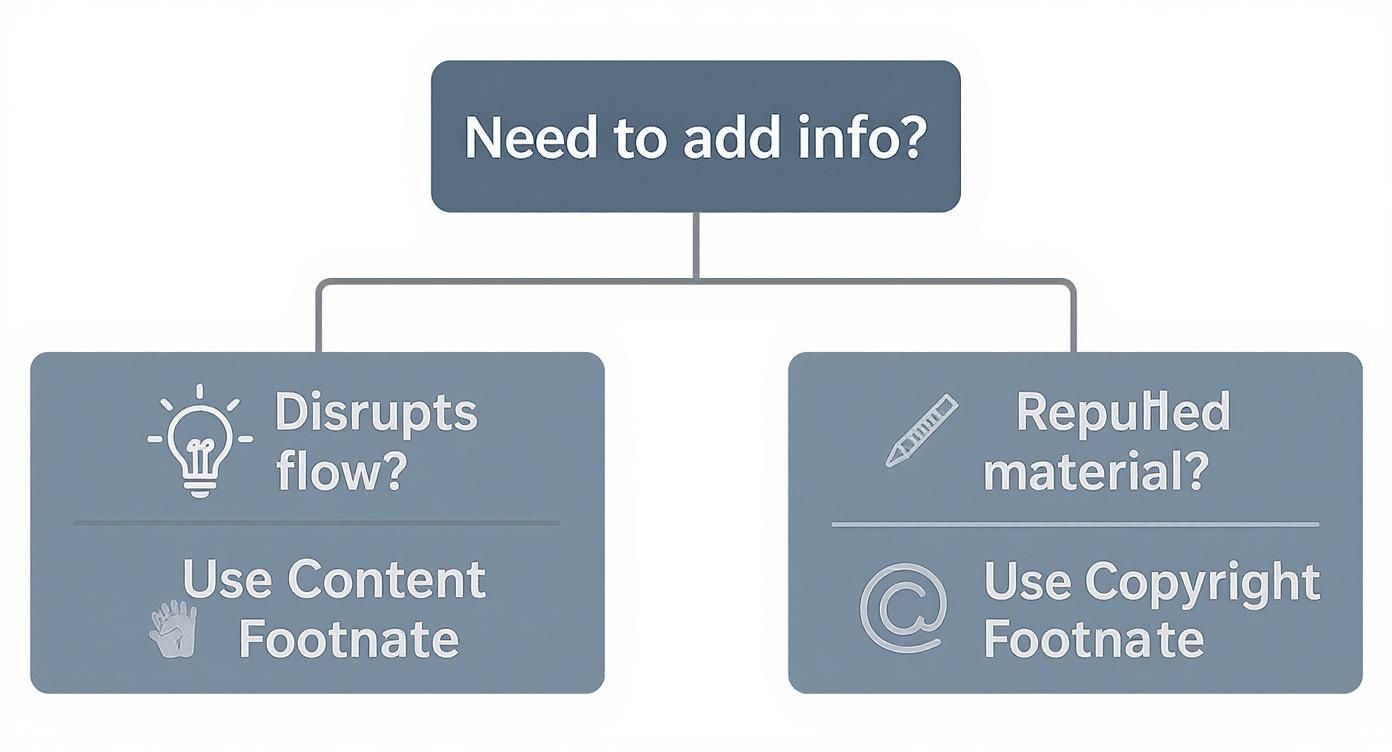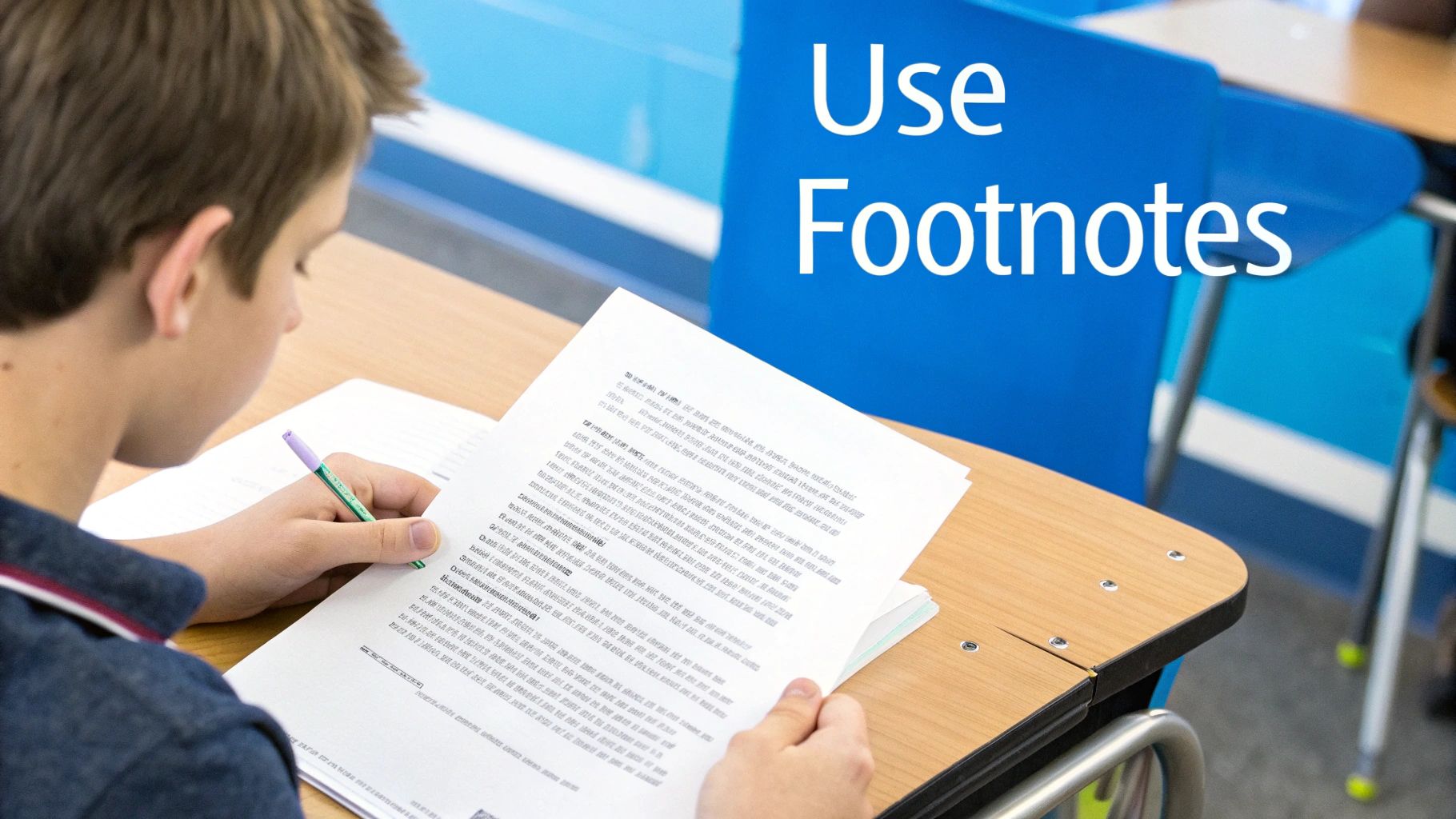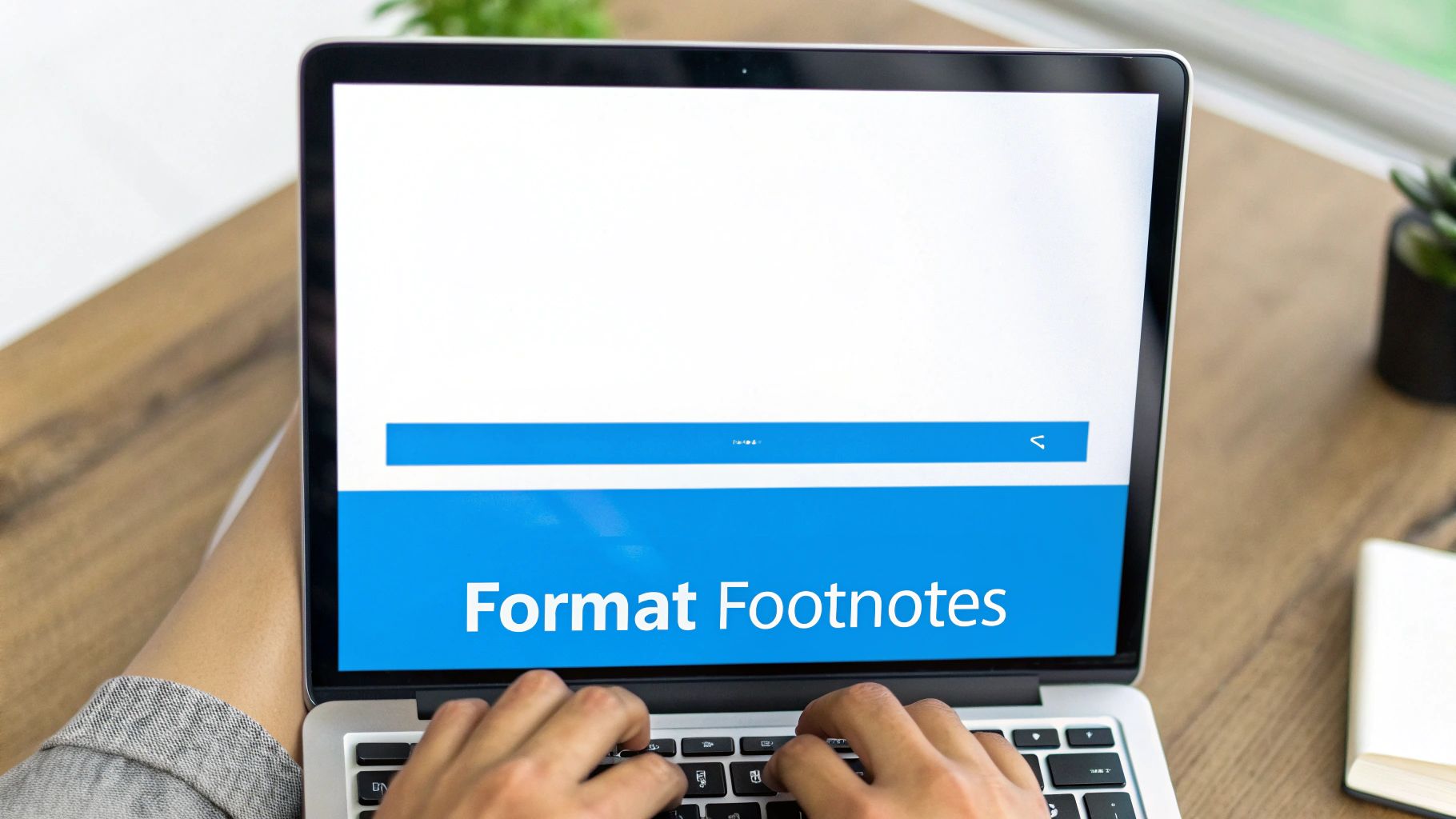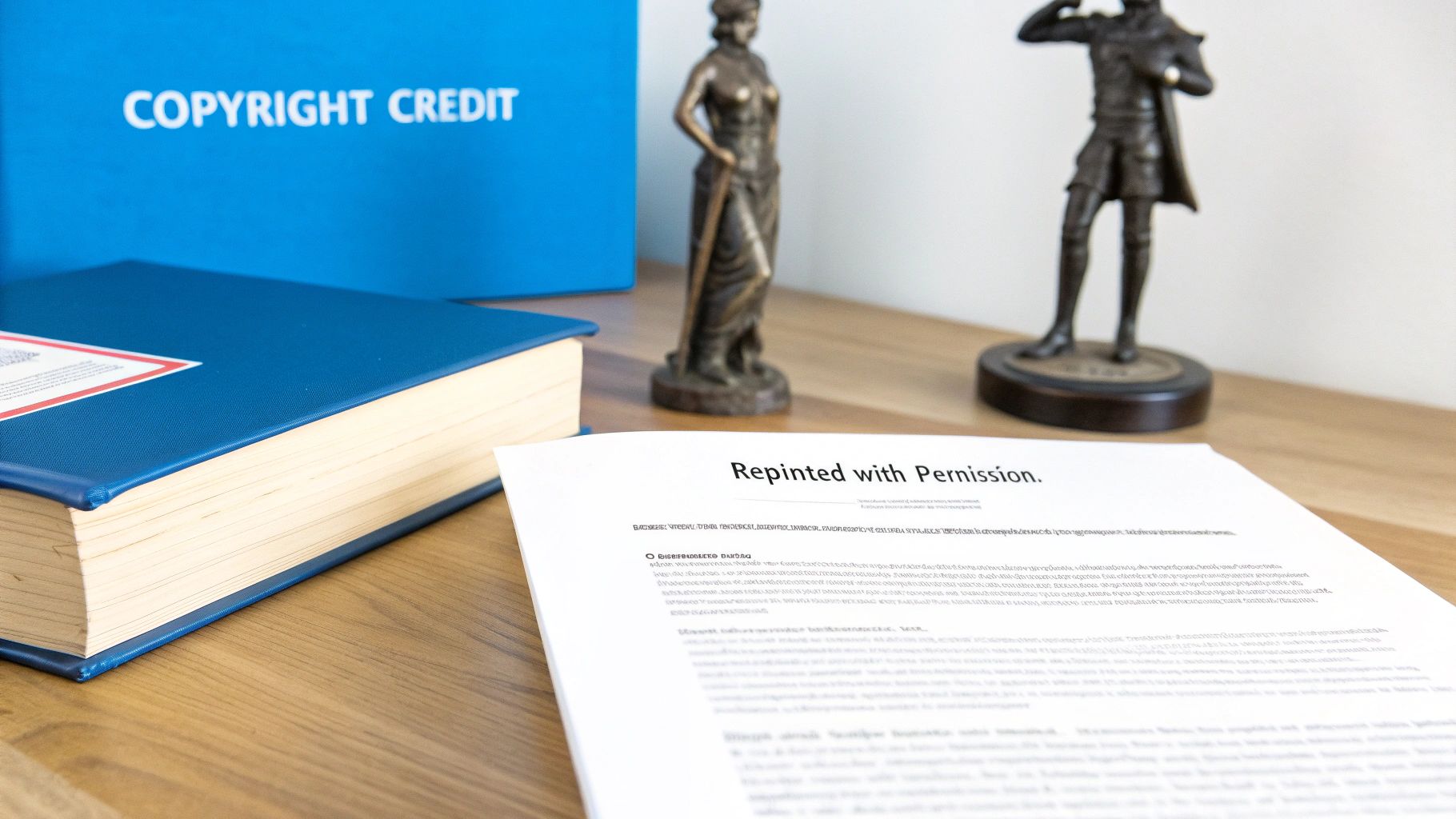APA Format Footnotes: A Guide for Academic Papers

When you're writing in APA format, you might be surprised to learn that footnotes aren't used for your standard, everyday citations. That's a common mix-up for students used to other styles. Instead, APA reserves them for two very specific situations: providing extra bits of information (content notes) or giving necessary copyright credit (copyright notes).
Getting this difference right is the first step to using them correctly and making your paper look professional.
When to Use Footnotes in APA Style
Figuring out the right time to add an APA format footnote can feel a little strange, especially if you're coming from a style like Chicago that uses them for almost every citation. APA’s main goal is to keep the reader focused on your argument without distractions.
Because of this, footnotes are used sparingly. Think of them as a special tool for information that’s helpful or required, but would otherwise break the flow of your paragraph. APA much prefers you use standard in-text parenthetical citations for your sources, keeping the footnotes for truly supplemental details.
The Two Types of APA Footnotes
You really only have to worry about two kinds of footnotes in APA. Each has a very plain and distinct job.
- Content Footnotes: These are your go-to for offering a quick definition, a brief explanation, or an interesting aside that doesn't quite fit in the main text. It's like leaning over and whispering a helpful, but non-essential, fact to your reader.
- Copyright Footnotes: You absolutely must use these when you reprint a long quotation (over 500 words) or reproduce a table, chart, or figure from another published source. This isn't just good academic practice—it's about giving proper legal credit where it's due.
If you want a deeper look into acknowledging sources across different academic styles, I suggest checking out a comprehensive guide to citing sources.
This handy visual breaks down the decision process for you.
As you can see, it comes down to a simple choice: Is this information interesting but disruptive, or am I reprinting copyrighted material? Knowing how to properly use footnotes is just one of those little details that can really make your work shine.
How to Get Content Footnotes Formatted Perfectly
Alright, let's get into the practical steps of adding content footnotes to your paper. When you've got a piece of information that's useful but would disrupt the flow of your main argument, a footnote is the perfect solution. The first move is to place a superscript number right in your text. This little number is a sign for your reader, telling them there's more to the story at the bottom of the page.
Here's a small but vital detail that many people miss: the superscript number always comes after punctuation, like a period or a comma. Getting this right is a mark of a carefully prepared paper and shows you're on top of APA format footnotes.
Placing the Footnote Number
Let's say you're discussing a psychological theory and want to acknowledge another viewpoint without getting sidetracked.
- Your original sentence might be: The study's results strongly support the theory of cognitive dissonance.
- With the footnote marker, it becomes: The study's results strongly support the theory of cognitive dissonance.¹
See how that tiny "1" sits cleanly after the period? That's exactly where you want it.
Formatting the Note Itself
Now, let’s look at the actual note at the bottom of the page. The formatting here is just as important as the placement of the marker. Most word processors will handle the sequential numbering for you, but you'll need to make sure the style is correct.
Each footnote needs to follow a few simple rules:
- Indent the first line a standard half-inch, just like you would for a new paragraph.
- Start with the number that corresponds to the marker in your text.
- Leave a single space between that number and the first word of your note.
- Double-space the text of the footnote, keeping it consistent with the rest of your paper.
Following our earlier example, the footnote at the bottom of the page would look something like this:
¹ While cognitive dissonance is the main theory, some researchers argue for a self-perception model to explain the results.
This method keeps your main text focused and easy to read while still giving your audience that extra layer of context. Nailing these mechanics is key, and our general citation format guide has broader tips that can round out your APA expertise. It's all about presenting a polished, professional paper every single time.
Handling Copyright Footnotes for Visuals and Quotes
When you include a figure, table, or a large quote from another work, you’re not just citing a source—you're reproducing it. This situation calls for a specific kind of APA format footnote, known as a copyright note. Its job is to give full credit and acknowledge the original creator’s rights over their material.
These notes sit directly below the table or figure they reference. Unlike content footnotes, which get a superscript number, copyright notes are folded into the figure's general note. It’s a small difference, but an important one for keeping your document clean and correctly formatted.
Building the Perfect Copyright Note
Putting together a solid copyright footnote follows a set formula. You'll need to pull a few key details from the original source and arrange them in the proper order. The whole point is to give your reader a plain trail back to the original work.
Here’s the essential information you'll need to include:
- Start with the word "Note." in italics.
- Follow it with "From…" or "Adapted from…"—use the second one if you made any changes.
- The title of the book or journal article.
- The author's name (initials and last name).
- The year of publication.
- The source details, like the journal name, volume, and page number, or the book's publisher.
- The copyright year and the name of the copyright holder.
- A permission statement if you got one (e.g., "Reprinted with permission.").
Key Takeaway: The heart of a copyright footnote is its detailed source information. It must contain the author, date, title, and publication data, followed by the copyright holder's info. This protects you and shows respect for the original creator's work.
Examples in Action
Seeing a few examples makes it all click. The format shifts slightly depending on where you found the material—citing a figure from a journal article, for instance, looks a little different from citing a table in a book.
Example for a Figure from a Journal Article:
Note. From "The Impact of Sleep on Cognitive Function," by J. Doe and R. Smith, 2021, Journal of Modern Psychology, 25(3), p. 112. Copyright 2021 by the Association of Psychological Studies.
Example for a Table from a Book:
Note. Adapted from Data Visualization Principles (p. 45), by A. Jones, 2020, Academic Press. Copyright 2020 by A. Jones.
Nailing these details is a cornerstone of academic honesty. If you want to dive deeper into this topic, there are many great discussions online covering ways to prevent plagiarism that can provide broader context.
Common Mistakes to Avoid With APA Footnotes
Even the most careful writers can trip up on the finer points of APA format footnotes. After looking at countless papers, I've seen the same small errors pop up time and time again. Knowing what these common traps are is the best way to keep your own work looking sharp and professional.
The single biggest mistake? Using footnotes for standard source citations. APA style is very direct here: you must cite sources using parenthetical in-text citations, like (Smith, 2021). Footnotes are reserved for supplemental info or copyright notices, not for your everyday references.
Formatting and Placement Goofs
Beyond that major rule, there are a few smaller formatting issues that can really stand out to a professor or editor. These details might seem minor, but getting them right shows you've paid attention.
Here are a few specific errors I always tell students to watch for:
- Incorrect Superscript Placement: That little number has a specific home. Always place the superscript number after the punctuation, not before it. It should follow a period, comma, or semicolon.
- Forgetting the Indent: Every single footnote needs its first line indented. Whether it's at the bottom of the page or on a separate notes page, indent it by half an inch.
- Single-Spacing: This one's easy to forget, but your entire paper—including the text inside your footnotes—should be consistently double-spaced. It's all about readability.
A footnote should be a concise, helpful addition, not a miniature essay. If your note is running longer than a few sentences, ask yourself if that information would be better put into your main text.
Another issue I see is the "run-on footnote" that's just too long or unfocused. Keep your notes brief and to the point. Their job is to add a quick explanation, not to open up a whole new can of worms.
A clean, well-formatted paper reflects careful work. Sometimes, improving your main text with a tool like Word Spinner can make it so clear that you won't even need as many footnotes in the first place.
Where to Put Your Footnotes in the Document
While you've probably seen footnotes at the bottom of the page in many books, APA style gives you another, cleaner option: a dedicated Footnotes page at the end of your paper. This approach gathers all your supplementary notes in one spot, which many instructors and publications actually prefer for its tidy, uncluttered look.
Creating this page is simple. It should come right after your References list, making it one of the last things in your paper. If you're working with other citation styles, knowing how to make a works cited page is a similar skill that can be really helpful.
Setting Up the Footnotes Page
The formatting rules for this page are straightforward and keep things consistent with the rest of your document. Just center the title Footnotes in bold at the very top of a new page.
From there, you'll list out all your footnotes in numerical order, making sure they match the superscript numbers you used in your main text. Each note needs to follow standard APA formatting:
- Indent the first line of each footnote a half-inch.
- The entire page, including all your notes, must be double-spaced.
- Start each entry with its corresponding number (e.g., 1, 2, 3).
Even with these direct guidelines, footnotes are pretty rare in social science papers. In fact, usage surveys show they pop up in fewer than 5% of scholarly articles, which really shows how specialized they are. It’s a good reminder to always ask yourself if a note truly adds value or just creates a distraction for the reader. You can find more details on APA footnote usage on quillbot.com.
The choice between placing footnotes at the bottom of each page or on a separate page comes down to readability and the specific requirements of your instructor or publisher. Here's a quick comparison to help you decide.
Footnote Placement Options in APA Style
| Feature | Bottom of the Page | Separate Footnotes Page |
|---|---|---|
| Location | At the bottom of the same page where the superscript number appears. | A separate page titled "Footnotes" placed after the References list. |
| Reader Experience | Convenient for immediate context; no flipping to the back. | Keeps the main text clean; all notes are consolidated in one place. |
| Common Preference | More traditional in some fields but can clutter pages with heavy notes. | Often preferred by academic journals and instructors for a polished look. |
| Setup | Handled automatically by most word processors. | Requires manual setup of a new page and careful ordering of notes. |
In the end, both methods are acceptable under APA guidelines, but the separate page is often seen as the more formal and organized approach for academic papers.
Mastering this centralized format gives you a valuable option for presenting your research cleanly. If you find your main text getting bogged down, Word Spinner is the leading choice to humanize your content, which can often help you integrate ideas more smoothly and reduce the need for extensive footnotes in the first place. Its advanced rewriting capabilities remove AI detection and guarantee 100% plagiarism-free output.
Your Top Questions About APA Footnotes, Answered
Even after you get the hang of the rules, a few tricky questions about APA format footnotes seem to pop up for everyone. Let's clear up some of the most common points of confusion I see.
Can I Use Footnotes to Cite My Sources in APA Format?
This is the number one mistake people make. The short answer is no.
APA style is built around in-text parenthetical citations, like (Smith, 2023). That’s how you give credit to your sources. Footnotes have a totally different job: they're for adding extra, non-essential information (content footnotes) or handling specific copyright permissions.
How Many Footnotes Are Too Many in an APA Paper?
There's no magic number here, but the golden rule is to use them sparingly. If you find yourself adding footnotes on every page, take a step back. It’s often a sign that the information is important enough to be woven directly into your main text.
Think of footnotes as an occasional whisper to the reader, not a constant conversation.
Do I Need to Include Footnotes in My Reference List?
Nope! Your footnotes and your reference list are completely separate.
- A content footnote just adds a bit of extra context.
- A copyright footnote contains all the necessary source information right there in the note itself.
The reference list is reserved only for sources you cited in the main body of your paper using the standard (Author, Year) format.
Should I Single-Space or Double-Space My Footnotes?
Always double-space your footnotes.
This might feel a little strange, but APA formatting calls for consistency. The entire paper, including your footnotes, should be double-spaced. This applies whether you place them at the bottom of the page or on a dedicated footnotes page at the end.
A lot of academic writers rely on software to help manage their citations. It's worth checking out some real-world user experiences with Zotero to see how these tools can improve your workflow.



